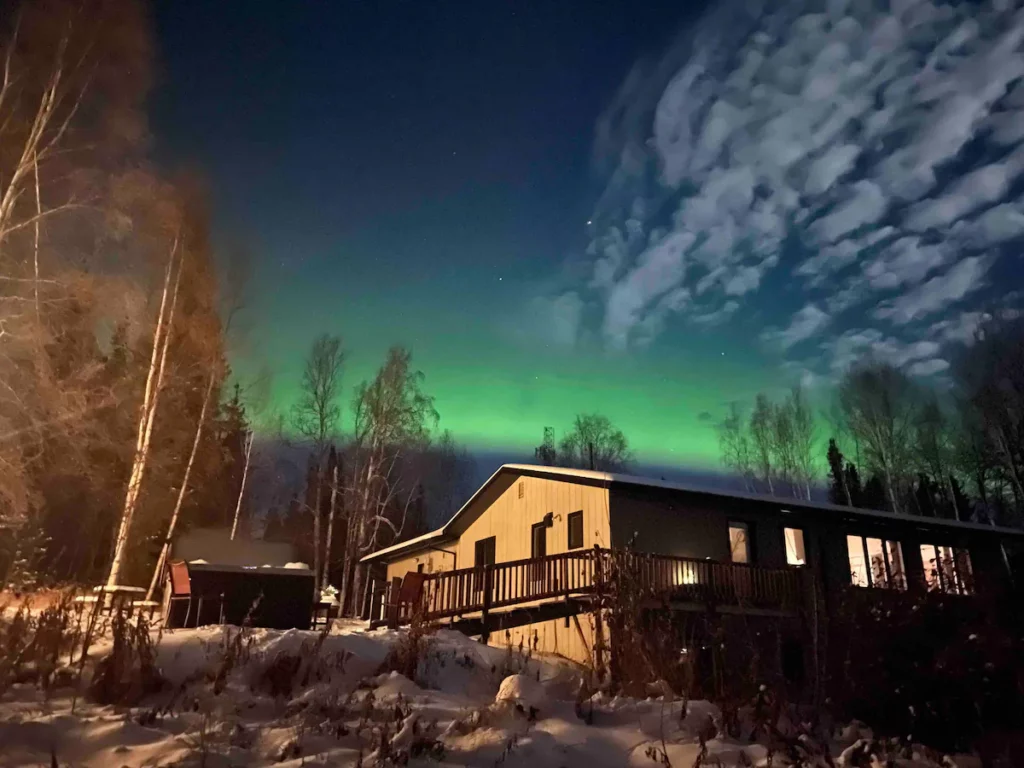Traveling to Alaska
Aurora is seen throughout the state of Alaska very easily, as long as the weather cooperates. The best place to go is the Fairbanks area. Most of what is on this page is about Fairbanks because that is where I live. Please see the other links for places to park to see the aurora from Anchorage, Talkeetna, and other locations.
Anchorage is another popular destination because it is a much larger city than Fairbanks. Aurora is easily seen, but not as often as Fairbanks and not as often overhead like Fairbanks. From Anchorage, you will most likely have to drive to see the aurora. It really depends on your viewing location. The aurora tour guides out of Anchorage are highly successful in seeing aurora and it is recommended to go on a tour to maximize your chances of seeing the lights.
Girdwood is a popular tourist destination for scenery but is not the best place to catch the aurora because of the terrain. The mountains block low aurora. You can see aurora from Girdwood if there is a larger aurora storm.
South of Anchorage such as Seward, Kenai and Homer, see aurora often, but not as often as Fairbanks.
Valdez sees aurora but cloudy weather is often an issue and terrain may block low aurora.
Juneau and Ketchikan see aurora when the Kp level is slightly higher at Kp 4 or higher. Watch for higher solar wind speeds and a minimum of Kp 3 in the forecast. Start watching when the current level is at Kp 1 or 2.
North of Anchorage, the Matsu Valley sees aurora the same as Anchorage. You may have to drive to get away from light pollution or terrain. Check out the webcam from Wasilla to check the weather and to see if the aurora is out. The aurora on this cam, when low or faint, is spotted on the upper left corner when it rises off the horizon.
Talkeetna is a good location to see aurora. Look to the north along the river or in openings in the trees that face north. On a moon filled night, you can see Denali with aurora shimmering above!
From the Denali National Park area and points north to Fairbanks, are super aurora watching locations. In the fall before the hotels at Denali close, most are great locations for viewing aurora!
North of the Matsu Valley toward Glennallen are good areas to catch the lights as long as the terrain doesn’t block the low view to the north. Glennallen and north to Delta Junction and Tok and great locations, nice and dark!
West of Anchorage off the road system such as Iliamna, Bethel, etc, are great locations to see aurora, almost no light pollution. Residents, teachers and transient workers will not have a problem seeing aurora.
Nome and the surrounding areas are good aurora locations but are on the edge of the aurora oval, so a higher Kp index such as Kp 1 or 2 is good to watch out for, however, since there is no light pollution, a low faint aurora can easily be seen to the north, northwest.
At the top of Alaska along the arctic ocean you may have to look south to see aurora because it is on the edge of the aurora oval. Truckers and tour guides on the Dalton Highway can enjoy aurora from Fairbanks all the way to the end of the road. The arctic circle sign, Coldfoot and Wiseman are good aurora locations to visit on tour. Traveling there with no guide is not recommended as there are few services and no cell signal.
Fairbanks
A good time to visit Fairbanks to see the northern lights is anytime between mid-August and mid-April. That is when we have dark skies at night. The best aurora shows are said to occur during equinox, fall and spring. This is due to the position of the earth, the location of the magnetic poles and the sun. The equinoxes also happen to be the best weather months, as it is not too cold, and the roads are usually clear of ice and snow. If you prefer open water, (auroras reflecting off the water) and colorful leaves, then visit in the fall. If you prefer dog sled rides, ice fishing on frozen lakes, visit in the spring. If you want to experience the deep cold and the darkest skies, visit between Nov and Feb. Aurora can be seen briefly in early August and early May, but it is dark only about 30 minutes to an hour, so visiting during this time is not recommended.

You may see other websites and social media posts mention “aurora season”. The aurora season does not start and end on a specific date abruptly, meaning there is no aurora the day before the “season”, it begins and ends due to astronomical twilight. The “season” is when the skies are dark enough to see the aurora, and also when tour operators start working. Tour operators do not want to take you out when the sky is only dark for 45 minutes, so they start and stop operating on certain dates, to give you more hours to enjoy the experience. You can see the aurora long before the “aurora season” starts. The sky in high latitude northern regions has 24 hours daylight during the summer, and the closer it gets to winter solstice (December) the darker it gets at night. For the southern hemisphere, the skies are darker the closer it gets to winter solstice in June. If you are visiting right before the season begins, or right after it ends, have a look in the sky at night at the darkest time, and you might see aurora (if space weather conditions are good).
For Fairbanks, Alaska, it is dark enough to see the aurora the first week of August. The time it is dark enough at night is only a couple hours, so if you are traveling to Fairbanks to see the aurora, it is best to come when the dark hours are longer, creating more of a chance to see the aurora. The same goes for the end of April, the closer it gets to May, the lighter the sky from sunshine. Aurora tour operators start up when the entire night is dark, greatly increasing your chances of being successful catching the aurora. Otherwise, the aurora is actually seen year round!
To view the aurora anytime of the year, you would need a geomagnetic storm big enough to reach down into middle latitudes. A Kp level of 5 or higher, generally, and high solar winds, may show auroras further south, where it gets dark at night. Examples include Calgary AB, Duluth MN, Minot ND, and even Vancouver BC, away from light pollution of course. European examples include northern England, Ireland, and Estonia. Australia and New Zealand in the southern hemisphere gets dark at night year-round. If you happen to be going to Antarctica, you will need to be there late March to late August to enjoy auroras. That is when it is dark at night, and up to 24 hours of darkness.
You can see the aurora in January, but the temperatures are brutally cold. You will take 1 or 2 photos and your fingers will feel numb without the proper gear. Then there is your camera freezing and the battery being drained. Keep all of this in mind when you come to Alaska. Have spare batteries. Bring the proper clothing, that is the key to staying warm. If you are a serious photographer and in need of camera protection, don’t rely on massed produced camera covers made for the lower 49. Get a Canadian made camera parka built for the arctic. Some tour groups provide gear/clothing. Plan ahead!

How cold does it get? It can and does get to -50F and sometimes colder, and does not let up for days, even weeks. Wind chill factor is not typically mentioned in Alaska. These are normal temperatures — well below zero. The insides of buildings are warm. Your hotel, room, cabin, and stores are warm. Dress in layers to go from staying inside to being outside. When you are using your vehicle to watch auroras, leave it running when it is very cold (suggestion is about -20 or colder). The car may get cold fast and it is highly possible it won’t start if it freezes. Make sure to turn off all your lights if you are near other people while watching the aurora.
HotHands warmers are a great way to keep your hands and toes warm in the extreme cold temperatures. Always have some in your emergency kit or camera bag. An emergency kit is a must when driving in Alaska, especially in the winter.
Emergency Kit list for when you drive in Alaska:
- packets of HotHands or ToeWarmers
- toilet paper
- flashlight or headlamp
- extra winter gloves
- blanket
- chain or tow strap
- snow shovel
The roads are snow-covered and icy from October to April. Residents driving from home to the store do not use chains to drive. Some people have snow tires, and some don’t. Truckers and busses sometimes carry chains in case they get stuck. If you are uncomfortable driving on the ice, there are many ways to drive out to see the aurora if not seen from town or your accommodation. You can hire a taxi driver, a guide, or join a tour group. We do have Lyft and Uber, but the availability is lacking at night, and the cost is higher than other cities.
*Please DO NOT go to Murphy Dome in the winter (Oct to March) if you are not experienced with driving on the ice. EVERY NIGHT, *yes EVERY NIGHT* in the winter, tow trucks are called up Murphy Dome Rd to rescue cars that slid off the road. Locals who live in that area have rescued people many times, and a few specifically have asked me to mention this (Amy). DO NOT go up that mountain in the winter. There is either NO cell signal, or it is weak in places, so calling the tow truck is done by flagging someone down. There are many many other places to park to see the aurora that are not as dangerous. It is foolish for some travel guides and official city guides to suggest this location during icy, snowy, and blizzard conditions.
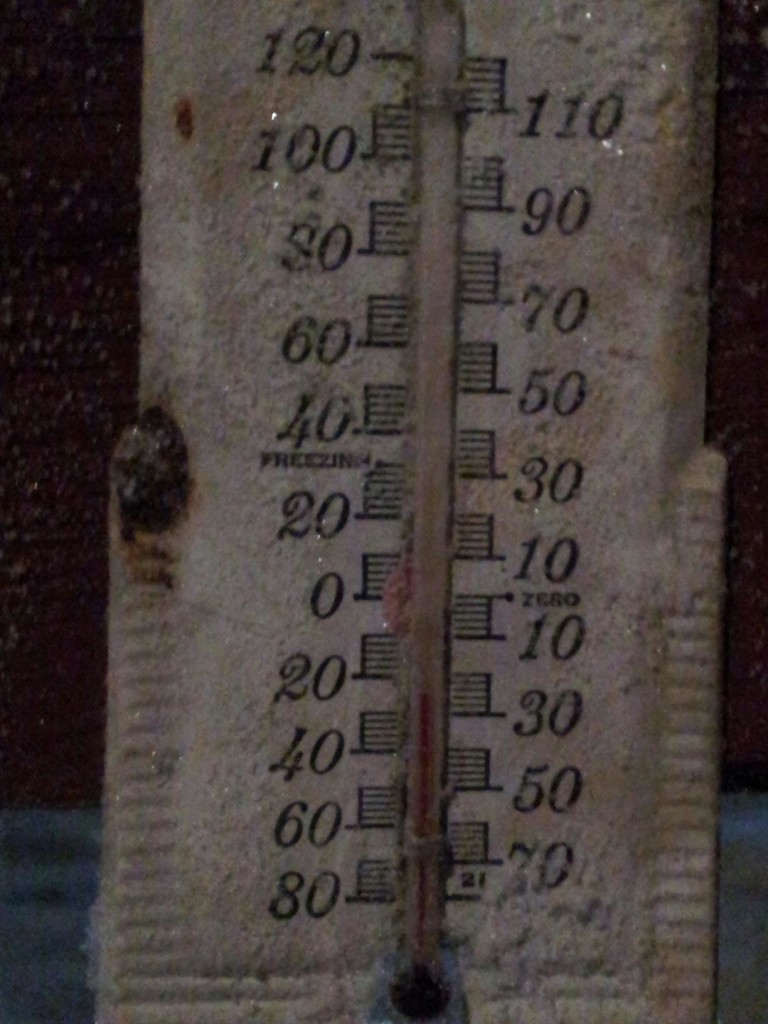
The Fairbanks Visitor’s Guide, TripAdvisor, and others have some good information concerning tours and trips, but use caution with suggestions that you can “only” see the lights with a guide, and use caution with visitors suggestions that are older than a year. This is due to constantly changing light pollution (added streetlights and so called improvements) and heavily marketed businesses. Light pollution is slowly destroying the Fairbanks area. Each year it worsens.
One common misconception is that you need to travel to certain businesses to see the aurora, and those businesses are very pricey. You can see the lights anywhere, not just high priced locations. Also, just because someone has lived here in Alaska all their life, does not mean they know anything about the aurora.
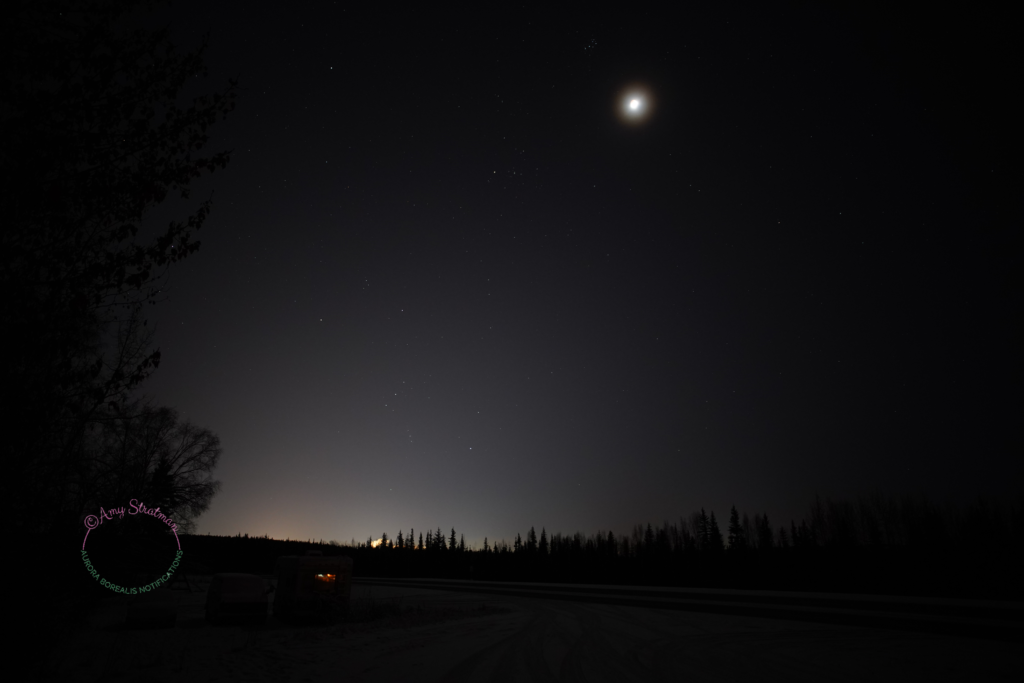
There are a few wonderful sponsors on this website that can assist you. You can see the aurora from SOME, not all B&B’s. You can find a place to stay without having to drive anywhere to see the aurora. You can see aurora from some hotels in town, but only if the aurora is strong, active, and overhead. You DO NOT have to spend hundreds of dollars to stay at certain accommodations with the “best” view.
Light pollution will diminish your enjoyment of the aurora. Fairbanks has light pollution, and it is getting worse every year due to changing out light fixtures to worse light trespass and to the wrong color for good night vision. If you are looking to see the aurora in all it’s beauty away from city lights, then reserve a place on the outskirts of the city, like Alaska Aurora Adventures, Aurora Moose Cottage, or Hygge House. Even 30 miles away is close when it comes to light pollution. In a darker location, you will see more structure, more color, and details in the shapes and lines of the aurora and in the stars. The milky way is easily seen away from town. Consider the outskirts of North Pole or Fox if you are driving yourself.
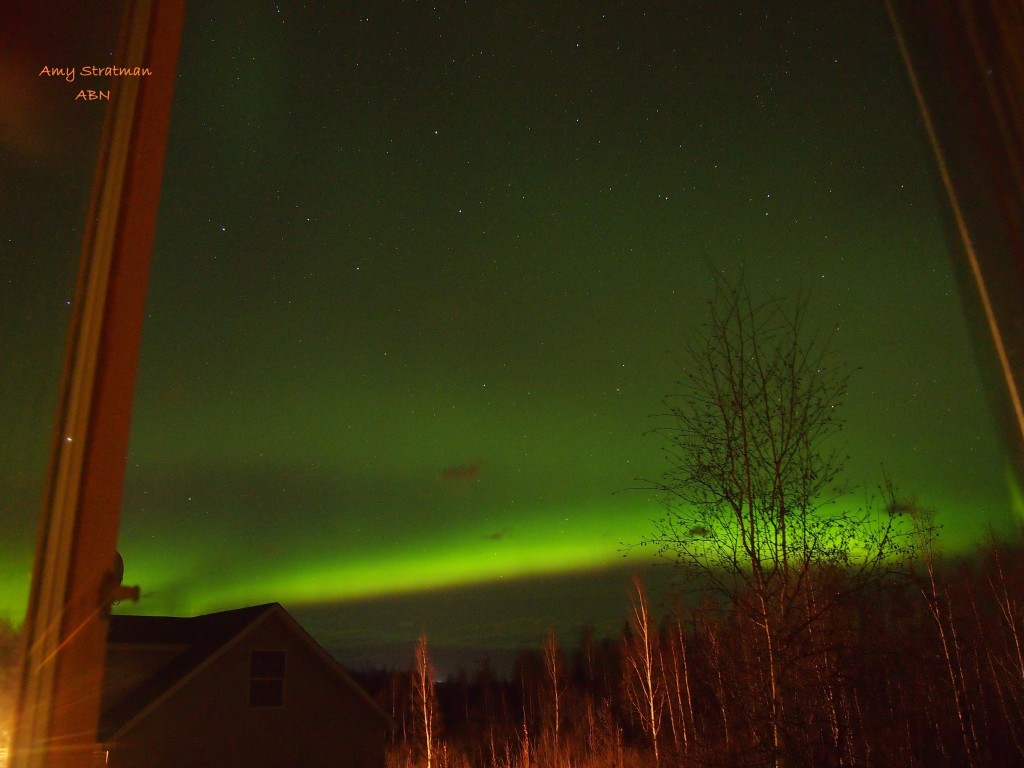
If you see a “whitish”, “white”, “gray”, “cloudy” or “faded” aurora, then you have not seen it properly, as aurora is not white. You may have seen a faint event or your eyes were not adjusted to the dark. Keep trying! Get away from light pollution, cover your car dashboard, dim your phone, and you will see the colors and vivid brightness with your own eyes! The aurora is well documented for centuries with descriptions of vivid colors. *Exception would be if you are colorblind.
Another suggestion is to pick the place you want to stay, and hire a tour guide or aurora business, and watch from the comfort of their facility or their vehicle. There are tours that drive to other destinations to find better weather or scenery. Most aurora tour businesses offer shuttle services from your accommodation. Each company is different, see their websites for specific details.

The Fairbanks area sees the aurora almost nightly. If the weather is clear, you have a great chance of seeing it. It is not always overhead, and it is not always bright. Look to your north, northeast, and low on the horizon if you can’t find it. Another trick is to find the Big Dipper star constellation. That will guide you in the right direction to look. Next time you see a photo of the northern lights, see if you can see the Big Dipper. Driving from the city to just a couple miles out of town will improve your night sky view.
Traveling to Alaska by air can be a long trip. There are some direct flights, but usually the flights go to Seattle, then up to Fairbanks with maybe a stop in Anchorage. There are only a few choices of airlines. If you are coming here for the northern lights, then you need to go to Fairbanks or the surrounding areas. Anchorage does see the aurora but it is considerably LESS often than Fairbanks, as it is 350 miles south. If you are only going to Anchorage on your visit, then you should plan on taking a drive further north (depending on the aurora and weather forecast) and being out all night long. See Where to Go From Anchorage. There are a few Anchorage aurora tour guides, and they most always drive outside the city. These guides are well worth it, finding the perfect area, driving back at 3-4 am, and keeping you safe and warm in the middle of the night. The Anchorage guides are passionate about the northern lights, you will not be disappointed. We suggest Greatland Adventures and Alaska Photo Treks.

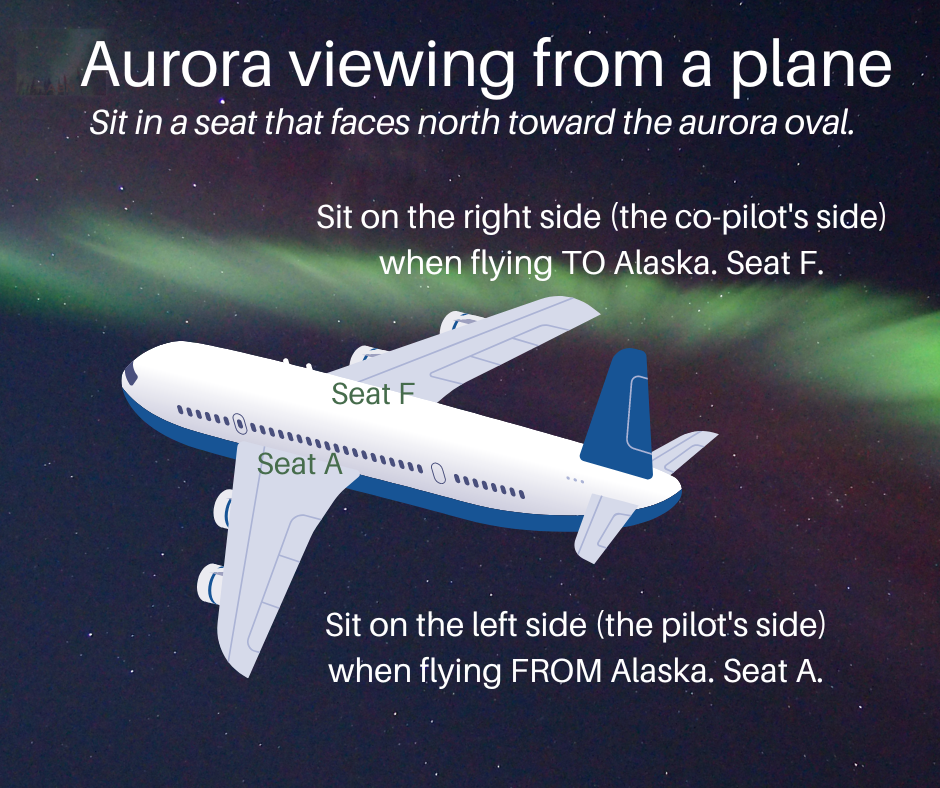
Should you go further north of Fairbanks? It is not necessary to drive to the arctic ocean or further north of Fairbanks other than to get out of light pollution. Fairbanks is well inside the aurora oval, and you can see aurora at Kp 0. Traveling several hours north will not guarantee you more “chances” at seeing aurora. The aurora is great where there is less light pollution. You can head north to the arctic circle sign, Bettles, Coldfoot, or Wiseman for great dark sky watching, but it is the wilderness and much further that it appears on the map. Driving yourself is NOT recommended. Please hire a tour guide. Another alternative to driving is flying, or half and half. You can have the guide drive you one way and fly back.
Northern Alaska Tour Company can take you on a dream vacation into the arctic circle. Call them to book. Each booking is done by phone with a travel expert that will book you exactly what you are looking for. They are a long time Alaska company that knows the northern roads.
For adventurous tours not as far as Coldfoot, Delta Junction is another great location. Delta is less than 85 miles from Fairbanks, on paved and plowed roads.
One overlooked tip for seeing the aurora: you have to be awake. The aurora is out at night, typically in the middle of the night. Wake up calls are ok (although commonly late, and commonly only done when the aurora is big), but just plan on being awake! Take naps. If you are in a hotel, and get an aurora wake up call, what is your plan? To catch the lights while standing under the security lights? That is not fully taking it in. You came all the way to Fairbanks, see the lights away from the city. It is worth it. No picture can show you how wonderful it feels to see the aurora lights in person. Adjust your time zone difference as soon as possible. If you are from the east coast (USA), then your bedtime is probably about 6pm Alaska time. Get some rest, then wake up! Another alternative is to go to bed, and wake up early, like around 3-4am. The northern lights are out often at that time, all the way to sunrise.
People ask when is the best time to see the aurora? That cannot be predicted for your travel plans. You do want clear weather, or the ability to travel to clearer weather and activities during the day. To choose the best time to travel for the experience you want, see historical weather patterns at World Weather Online, or other similar sources. Choose which activities you would like to do in the location you are traveling to by looking at the local visitors center website or Chamber of Commerce.
When driving in Alaska, watch for wild animals in the road. Moose are commonly seen and typically “pop out of no where”, especially when it is dark. Read “Driving in Moose Country” here. Also watch for bear, lynx, porcupine, and more.




